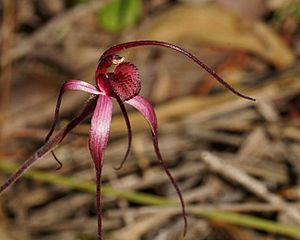Large crimson spider orchid facts for kids
Quick facts for kids Large crimson spider orchid |
|
|---|---|
 |
|
| Conservation status | |
| Scientific classification | |
| Genus: |
Caladenia
|
| Species: |
formosa
|
| Synonyms | |
|
Arachnorchis formosa (G.W.Carr) D.L.Jones & M.A.Clem. |
|
The Large Crimson Spider Orchid (scientific name: Caladenia formosa) is a beautiful plant. It's also called the Elegant Spider Orchid. This special orchid belongs to the orchid family. You can only find it growing naturally in Victoria and South Australia in Australia. It's a ground orchid, meaning it grows in the soil, not on trees. It has one fuzzy leaf and a single, bright crimson (deep red) flower. Most of these orchids live in southwestern Victoria.
Contents
What the Large Crimson Spider Orchid Looks Like
The Large Crimson Spider Orchid is a plant that grows from an underground tuber, which is like a small storage root. It's a perennial plant, meaning it lives for more than two years. It's also a deciduous herb, so its leaves might die back in some seasons.
Each orchid has one reddish-green leaf. This leaf is quite hairy and can be about 80 to 190 mm (3 to 7 in) long. It is also about 5 to 12 mm (0.2 to 0.5 in) wide.
The orchid usually grows one flower, but sometimes it can have two. These flowers are pale red to crimson. They are about 40 to 60 mm (1.6 to 2.4 in) wide. The flower grows on a hairy stem that can be 200 to 600 mm (8 to 20 in) tall.
The flower has parts called sepals and petals. These parts become very thin at their tips. These tips are covered with tiny glands and hairs. The top sepal, called the dorsal sepal, stands upright. It is about 40 to 80 mm (1.6 to 3.1 in) long. The side sepals are also 40 to 80 mm (1.6 to 3.1 in) long. The petals are about 40 to 60 mm (1.6 to 2.4 in) long.
The most interesting part is the labellum, which is a special lip-like petal. It is about 16 to 20 mm (0.6 to 0.8 in) long. The edges of the labellum curl upwards, and its tip rolls under. It is pink to red. Along its edges, there are red teeth up to 2 mm (0.08 in) long. In the middle of the labellum, there are four or six rows of long, red structures called calli. These orchids usually bloom from September to October.
How This Orchid Got Its Name
The scientific name Caladenia formosa was first officially described in 1991. It was named by a scientist named Geoffrey Carr. He found a sample of this orchid in the Dergholm State Park.
The word formosa comes from Latin. It means "beautifully-formed" or "handsome." This name perfectly describes the orchid's lovely appearance.
Where the Large Crimson Spider Orchid Lives
The Large Crimson Spider Orchid likes to grow in forests and woodlands. It prefers well-drained soil, often found among shrubs or grass.
Today, this orchid is only known to grow in certain areas. These areas are between Cavendish, Penola, Kingston SE and Keith. Scientists believe that in the past, it probably grew in many more places.
Protecting This Special Orchid
The Large Crimson Spider Orchid is considered "vulnerable." This means it is at risk of disappearing if we don't protect it. Both the Victorian Government and the Australian Government have laws to protect it. These laws are the Victorian Flora and Fauna Guarantee Act 1988 and the Australian Environment Protection and Biodiversity Conservation Act 1999.
In 2010, experts estimated there were only about 450 individual plants left. These plants were found in fourteen different groups. The biggest dangers to this orchid are:
- Weed invasion: Weeds can grow over the orchids and take their nutrients.
- Habitat loss: Land is being cleared for other uses, destroying the orchid's home.
- Rubbish dumping: Trash can harm the plants and their environment.
- Grazing: Animals like rabbits and cattle can eat the orchids.
Protecting these beautiful orchids helps keep our natural world diverse and healthy.


